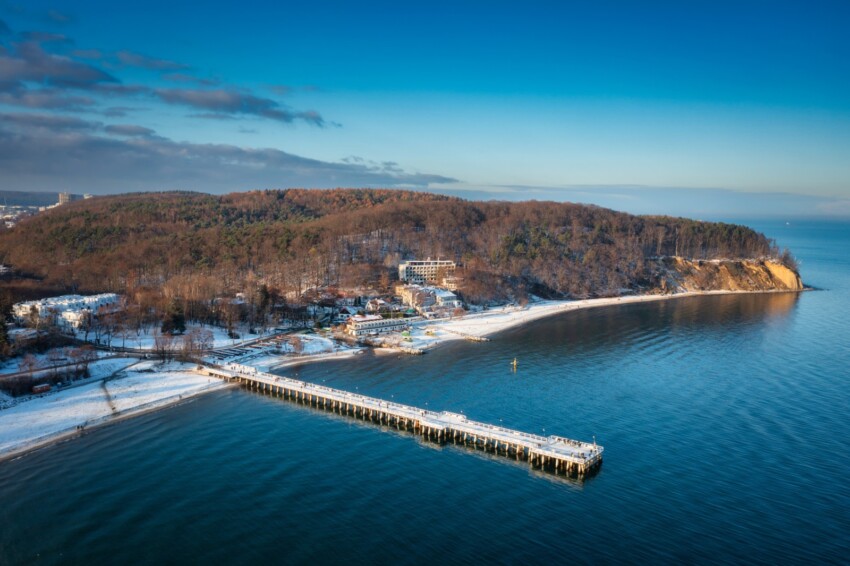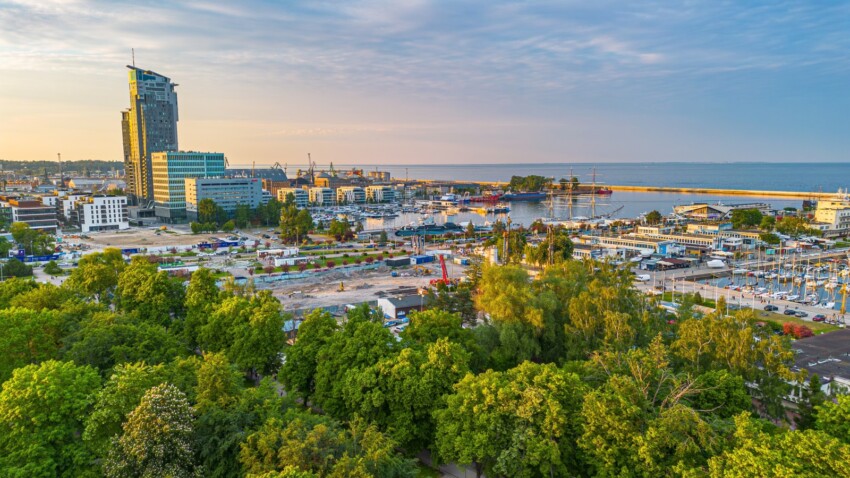

Gdynia is a city with maritime charm Originally a small fishing village, Gdynia developed into an important trading port and a lively coastal city in the 20th century, becoming an integral part of the famous Triple City along with Gdansk and Sopot.
The city is renowned for its modernist architecture from the 1920s and 1930s, which gives it a distinctive character compared to other Polish cities.
Sea lovers will appreciate the sandy beaches, lively marinas and the opportunity to explore historical ships turned into museums. At the same time, Gdynia is a young and dynamic city with a lively cultural scene, international festivals and a gastronomy that celebrates the flavours of the sea and Polish tradition.

Gdynia, despite its young age as a city, offers a surprising variety of attractions ranging from maritime history to modernist architecture and unique natural and cultural experiences. Here is a selection of the main attractions that make Gdynia a fascinating destination to explore.
The Maritime Museum (Muzeum Marynarki Wojennej) in Gdynia is a must for fans of naval and military history. Located in an attractive modern building, the museum offers a comprehensive overview of Polish naval history from the Middle Ages to the present day.
The museum’s extensive collections include ship models, uniforms, weapons, historical documents and artefacts recovered from the bottom of the Baltic Sea. Especially interesting are the interactive exhibits that allow visitors to experience life on board a warship.
Outside the museum, several full-scale military vessels can be admired, including the destroyer ORP Błyskawica, one of the few surviving ships from the Second World War, which now serves as a museum ship permanently anchored in the port of Gdynia.
The Gdynia Aquarium is a must-see for families and marine life enthusiasts. Located on the waterfront, this modern complex houses a wide range of aquatic creatures from all over the world.
Visitors can explore different aquatic habitats, from the Baltic Sea to tropical oceans and Amazonian rivers. Highlights include large sharks, colourful coral reefs and rare Amazonian fish species.
The aquarium also offers educational programmes and interactive demonstrations, making the visit not only fun but also informative. A particularly exciting experience is the chance to touch some sea creatures in special tanks, under the supervision of the staff.
Kościuszko Square is the beating heart of Gdynia and the ideal starting point for exploring the city. This large square overlooks the sea and offers a panoramic view of the Gulf of Gdansk.
In the centre of the square is the monument to Józef Piłsudski, a key figure in Polish history. The square is surrounded by modernist buildings characteristic of Gdynia, including the famous ZKP Building with its iconic rounded shape.
From Kościuszko Square starts Gdynia’s picturesque promenade, perfect for relaxing walks. Along the way you will find numerous cafés, restaurants and ice cream parlours, ideal for a break overlooking the sea. The promenade is particularly impressive at sunset, when the lights of the city are reflected in the water.
The Południowe, or South Pier, is one of Gdynia’s most iconic attractions. This long pier stretches into the Gulf of Gdansk, offering a beautiful seaside promenade and panoramic views of the city and bay.
At the end of the pier is the famous statue of the Dream Fisherman, a modern work of art that has become one of the symbols of Gdynia. The statue, representing a man trying to catch the moon with a fishing net, is particularly impressive at sunset.
The pier is also home to several museum ships, including the most famous ORP Błyskawica, a World War II destroyer, and the sailing ship Dar Pomorza. These ships offer visitors the opportunity to explore Gdynia’s maritime history up close.
The Gdynia City Museum is the perfect place to immerse yourself in the history and culture of this young but fascinating city. Located in a restored modernist building in the city centre, the museum offers a comprehensive overview of Gdynia’s development from a small fishing village to an important seaport and modern city.
The museum’s permanent exhibitions tell the story of Gdynia through period photographs, documents, everyday objects and architectural models. Particularly interesting is the section devoted to modernist architecture in Gdynia, which explains how the city’s unique style developed in the 1920s and 1930s.
The museum also hosts temporary exhibitions on various aspects of local culture and history, as well as events and workshops involving the local community and visitors.
Kamienna Góra, or Stone Hill, is a green oasis in the heart of Gdynia that offers one of the best panoramic views of the city and the Gulf of Gdansk. This wooded hill rises 54 metres above sea level and is accessible either on foot or via a free funicular.
At the top of the hill is a viewpoint with a large illuminated cross, visible from much of the city at night. From here, visitors can enjoy a breathtaking view stretching from the port of Gdynia to Sopot and Gdańsk.
Kamienna Góra is also a popular place for relaxation and outdoor activities. The park surrounding the hill offers walking paths, picnic areas and a children’s playground. During the summer, the hill often hosts outdoor events and concerts.
The Orłowo district, located in the southern part of Gdynia, is one of the most picturesque areas of the city. Known for its quiet atmosphere and beautiful beaches, Orłowo offers a relaxing contrast to the more lively centre of Gdynia.
The centrepiece of Orłowo is its characteristic wooden pier, which extends into the Gulf of Gdansk. Although smaller than the famous Sopot Pier, the Orłowo Pier has a unique charm, offering spectacular views of the bay and surrounding cliffs.
Nearby is Orłowo beach, one of the most beautiful in the area, perfect for relaxing or taking a stroll along the shore. The beach is flanked by cliffs that offer an impressive panorama, especially at sunset.
The district is also known for its high-quality seafood restaurants, where you can enjoy local specialities overlooking the sea.
The Centrum Nauki Experyment (Experyment Science Centre) is an interactive museum dedicated to science and technology, perfect for visitors of all ages, but especially popular with families with children.
This modern science centre offers over 200 interactive exhibits divided into different thematic areas, including physics, biology, mathematics and earth sciences. Visitors can participate in hands-on experiments, explore natural phenomena and learn scientific concepts in a fun and engaging way.
Among the most popular attractions are the earthquake simulator, the bubble chamber and various logic and perception games. The centre regularly organises workshops and science demonstrations that make the visit even more educational and stimulating.
In the following map you can see the location of the main places of interest mentioned in this article.
The city is relatively compact, so most accommodation is conveniently located for exploring the main attractions.
The city centre, near Kościuszko Square and the waterfront, is the most popular area to stay. Here you will find numerous mid- and upscale hotels, many of which offer sea views. This area is ideal for those who want to be in the heart of the action, with easy access to restaurants, shops and major tourist attractions.
For those looking for a quieter atmosphere, the Orłowo district offers various accommodation options, from guesthouses to flats for rent. This area is perfect for those who want to enjoy beautiful beaches and a more relaxed atmosphere, while remaining within easy reach of the city centre.
The Redłowo district, located between the centre and Orłowo, is another good option, with a mixture of modern hotels and rental flats. This area offers a good balance between tranquillity and access to city attractions.
Gdynia, part of the Triple City along with Gdańsk and Sopot, is well connected with both the rest of Poland and Europe.
Gdańsk Lech Wałęsa Airport is the main air access point for Gdynia, located about 25 km from the city. From the airport, it is possible to reach Gdynia in about 40 minutes by train thanks to the PKM (Pomeranian Metropolitan Railway) line, which connects the airport to Gdynia Główna station with frequent trains.
Gdynia has a main railway station (Gdynia Główna) that is well connected to major Polish cities. High-speed trains from Warsaw take about 3½ hours. .
For those arriving by car, Gdynia is easily accessible via the A1 motorway, which connects the city with central and southern Poland. The E28 European road connects Gdynia with western Germany.
The port of Gdynia is an important ferry hub, with regular connections to Sweden (Karlskrona) and occasionally to other Baltic countries.
What's the weather at Gdynia? Below are the temperatures and the weather forecast at Gdynia for the next few days.
Gdynia si affaccia sul Mar Baltico, nella parte settentrionale della Polonia a circa 22 km a nord di Danzica e 380 km a nord di Varsavia.